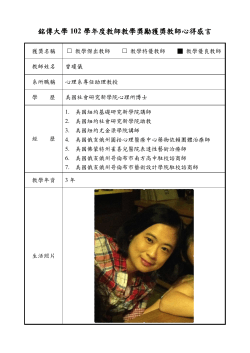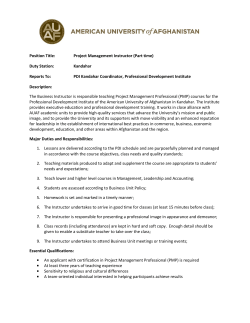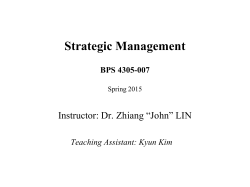
The Making of an Effective Online Instructor
The Making of an Effective Online Instructor Amy Myer, CI7070, Spring 2013 1. Mindset: Be A Reflective Practitioner Golden Rule: Be a reflective practitioner who is continually honing his teaching practice. Without this, it is unlikely that he will be able to successfully make the pedagogical shift to online teaching. a. Teaching online requires a whole different set of strategies, tools, and techniques. Repackaging a face-toface class won’t work. b. Take a “life-long” learning approach to professional development, recognizing that technologies and best practices in online education evolve quickly. c. Collect student feedback at defined intervals to fuel course revisions. “Every course is a Beta test.” 2. Instructor Presence: Be There Golden Rule: Be a constant, timely, and upbeat presence in the class. The instructor must replace the face-to-face interactions and immediacy factors (gestures, body language, etc.) with their online equivalents. a. Feedback should be prompt, relevant, regular, and personalized. State your response time parameters (e.g. 24 hours for email, 48 weekend, 3 days for grading) - and then keep your promise. b. Virtual office hours should be available, kept, and occur at times that meet online learner needs (not 9-5!) c. Use class-wide Q & A discussion boards to minimize emails and foster connectedness d. Be IN the course: Enter discussion boards, show emotion, praise students’ efforts, send regular announcements, provide personal examples, address students by first name, use humor (effectively). 3. Organization and Planning: Prepare Golden Rule: Course Structure is the cognitive framework and supports learning. a. Online courses are designed upfront before the course begins, course time is spent interacting with and responding to students, addressing difficult subject matter, and engaging in discussion boards. b. Use good instructional design principles: course topics based on objectives, a variety of assessments based on learning objectives, etc. Make it as real world as possible so that learners understands the relevance to them. c. Use a consistent course layout, since it is the cognitive replacement of the physical classroom. d. Provide clear evaluation rubrics for assignments e. Don’t muck with the course schedule except to fix grievous errors. 4. Student Engagement: Build a Classroom Community Golden Rule: Connectedness fosters student engagement. Design for opportunities for interaction and student contribution to keep them motivated and connected with the course. a. Design (i.e. plan) instructor->student (via presence) interactions & student-to-student interactions b. Express and have concern for student learning c. Provide a variety of activities and assessments (within a consistent course management structure) to vary the course and provide opportunities for different types of learners. d. Have students contribute to the course by adding supplemental material, posting podcast summaries or via class discussion. e. Include supplemental materials that are interesting and fun and engaging to students to keep them involved. References Baghdadi, Z. D. (2011). Best practices in online education: Online instructors, courses, and administrators. Turkish Online Journal of Distance Education, 12(3), 109-117. Fish, W. W., & Wickersham, L. E. (2009). Best practices for online instructors: Reminders. Quarterly Review of Distance Education, 10(3), 279-284. Schutt, M., Allen, B. S., & Laumakis, M. A. (2009). The effects of instructor immediacy behaviors in online learning environments. Quarterly Review of Distance Education, 10(2), 135-148. Sull, Errol Craig. (2010). Secrets of the successful online instructor revealed. Distance Learning, 7(4), 98. …. plus a smattering of personal experience
© Copyright 2025





















